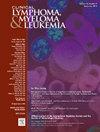Lenalidomide in Transfusion-Dependent IPSS Low- or Intermediate-1-Risk Myelodysplastic Syndromes and Isolated Del(5q): Results of a European Postauthorization Safety Surveillance Study
IF 2.7
4区 医学
Q2 HEMATOLOGY
引用次数: 0
Abstract
Background
This noninterventional postauthorization safety study assessed the safety and effectiveness of lenalidomide in patients with transfusion-dependent, International Prognostic Scoring System (IPSS) Low- or Intermediate (Int)-1-risk myelodysplastic syndromes (MDS) associated with isolated deletion of 5q (del[5q]) who were treated in routine care.
Patients and Methods
Eligible adult patients in the lenalidomide cohort had transfusion-dependent, IPSS Low- or Int-1-risk MDS and isolated del(5q) and had received ≥ 1 dose of lenalidomide between 2014 and 2022. The primary endpoint was the 24-month cumulative incidence of acute myeloid leukemia (AML) progression. Overall survival (OS) was estimated by Kaplan–Meier analysis and safety data were collected.
Results
In total, 296 patients received ≥ 1 dose of lenalidomide (lenalidomide cohort, safety population) and 277 had received ≥ 1 complete cycle of lenalidomide (primary population). In the safety population, 44.3% of patients completed 3-year follow-up and 55.1% discontinued, with 33.1% discontinuing due to death. In the primary population, 24-month cumulative incidence of AML progression was 12.7% (95% confidence interval, 8.9%-17.1%) and estimated OS probability was 78.3% at 24 months and 63.9% at 36 months. Grade 3/4 treatment-emergent adverse events were experienced by 67.2% of the safety population, and these led to discontinuation in 35.5% of patients. There were no new safety signals.
Conclusion
These real-world data support the established benefit-risk profile of lenalidomide in transfusion-dependent IPSS Low- or Int-1-risk MDS with isolated del(5q).
来那度胺治疗输血依赖性 IPSS 低危或中 1 危骨髓增生异常综合征和孤立 Del(5q):欧洲授权后安全性监测研究结果。
研究背景这项非干预性授权后安全性研究评估了来那度胺对输血依赖型、国际预后评分系统(IPSS)低风险或中(Int)-1风险骨髓增生异常综合征(MDS)伴孤立性5q缺失(del[5q])且接受常规治疗的患者的安全性和有效性:来那度胺队列中符合条件的成年患者均为输血依赖型、IPSS低危或Int-1危MDS和孤立性del(5q),且在2014年至2022年期间接受过≥1次来那度胺治疗。主要终点是24个月内急性髓性白血病(AML)进展的累积发生率。总生存期(OS)通过卡普兰-梅耶尔分析进行估算,并收集了安全性数据:共有296名患者接受了≥1个剂量的来那度胺(来那度胺队列,安全人群),277名患者接受了≥1个完整周期的来那度胺(主要人群)。在安全人群中,44.3%的患者完成了3年随访,55.1%的患者中断了随访,其中33.1%的患者因死亡而中断随访。在主要人群中,24个月的急性髓细胞性白血病进展累积发生率为12.7%(95%置信区间,8.9%-17.1%),24个月和36个月的估计OS概率分别为78.3%和63.9%。67.2%的安全人群出现了3/4级治疗突发不良事件,其中35.5%的患者因此停药。没有出现新的安全性信号:这些真实世界的数据支持来那度胺治疗输血依赖性IPSS低危或Int-1危孤立del(5q)MDS的既有获益-风险特征。
本文章由计算机程序翻译,如有差异,请以英文原文为准。
求助全文
约1分钟内获得全文
求助全文
来源期刊

Clinical Lymphoma, Myeloma & Leukemia
ONCOLOGY-HEMATOLOGY
CiteScore
2.70
自引率
3.70%
发文量
1606
审稿时长
26 days
期刊介绍:
Clinical Lymphoma, Myeloma & Leukemia is a peer-reviewed monthly journal that publishes original articles describing various aspects of clinical and translational research of lymphoma, myeloma and leukemia. Clinical Lymphoma, Myeloma & Leukemia is devoted to articles on detection, diagnosis, prevention, and treatment of lymphoma, myeloma, leukemia and related disorders including macroglobulinemia, amyloidosis, and plasma-cell dyscrasias. The main emphasis is on recent scientific developments in all areas related to lymphoma, myeloma and leukemia. Specific areas of interest include clinical research and mechanistic approaches; drug sensitivity and resistance; gene and antisense therapy; pathology, markers, and prognostic indicators; chemoprevention strategies; multimodality therapy; and integration of various approaches.
 求助内容:
求助内容: 应助结果提醒方式:
应助结果提醒方式:


